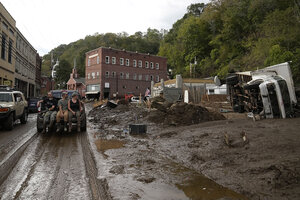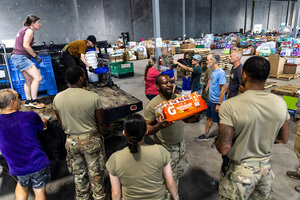Helene ravaged North Carolina’s mountains. Its citizens are hollering back.

People ride in the back of a pickup truck on a mud-covered street left in the aftermath of Hurricane Helene, Oct. 1, 2024, in Marshall, North Carolina.
Jeff Roberson/AP
HENDERSONVILLE and SALUDA, N.C.
Eric Gillespie put his sandals on, walked outside his house, and stood in awe at the sight of Clear Creek – usually a gurgling rivulet – rushing like a dark torrent.
Then he heard the screams for help. Down a steep bank lay a row of cookie-cutter houses, now up to their eaves in muddy water. Friends and neighbors – some infirm – remained in their homes as nearly 30 feet of water rushed down the French Broad River system, rising in a matter of minutes, trapping a dozen neighbors unable to scramble to higher ground.
“That’s when things got crazy,” says the owner of the Wakey Monkey coffee shop in nearby Saluda. “There was no way to prepare for what happened.”
Why We Wrote This
As Florida regroups from Wednesday’s Hurricane Milton, it’s been two weeks since Hurricane Helene roared into the Appalachian Mountains. How a wrecked region recovers will depend on local resilience. And it’s there.
In a rescue scene replicated over 6,000 times across Appalachia as remnants of Hurricane Helene crashed into the steep terrain, neighbors and first responders rushed to action, using everything from sofa cushions and paddleboards to mules and Chinook helicopters in order to ferry friends and strangers to safety. Over 230 people died in the storm, the bulk of them in Appalachia. The toll includes 11 members of one family in the Asheville suburbs.
“There was both beauty and tragedy in the response,” says Nathan Smith, a pilot from Charlotte, North Carolina, who surveyed the damage as he flew his 1979 Cessna 180 Skywagon on multiple missions into hard-hit county airports.
Nature’s worst meets America’s best
According to the North Carolina state climate office in Raleigh, Helene poured 31 inches of rain into the Busick, North Carolina, rain gauge, setting off one of the largest national emergency efforts since the flawed response to Hurricane Katrina nearly 20 years ago.
There were slip-ups and mistakes. But to many on the front lines here, the very worst that nature could conjure was met by the very best America had to give.
Now, about two weeks after the floods struck and receded, a drama-filled rescue effort has given way to a full swing clawback as roads open and lights flicker on.
While questions around what aid is going to arrive and when still swirl, what promises to be a long recovery is now top of mind for residents of Greater Appalachia, many of them exhausted and still in shock at the discombobulation not only of their lives, but also of the geography of their valleys.
“Remember that your community is here for you, your state is here for you, your country is here for you,” Republican Rep. Chuck Edwards wrote to constituents on Oct. 2. “Mountain people are strong, and we are resilient.”
But in Saluda, North Carolina, a railroad stop that became an adventure destination, the tone of the first meeting of the local business association after the storm was subdued at best.
What happens next
The Green River, a world-renowned kayaking destination, could remain impassable for months, if not years, some association members said. With major roads blocked and tourist towns like Bat Cave and Chimney Rock leveled, would anyone show up for leaf-peeping season?
“What happened was scary,” says Emily Lamar, co-owner of The Purple Onion restaurant in Saluda. “What happens next is scary, too.”
Access issues for rescue crews tell that story. There is little way to get from South Carolina to Tennessee as parts of Interstate 40 are washed out. The famous Blue Ridge Parkway is undrivable, covered with trees and washouts. Large parts of Asheville’s quirky River Arts District are smashed. Much of what was the iconic village of Chimney Rock is now wreckage situated downstream in Lake Lure.
“The effects keep rippling out,” says Karen Neff, who moved to Saluda from Florida two years ago.
One analogue is the city of New Orleans, which lost more than a quarter of its population between 2005 and 2011. But just as New Orleans used that experience to strengthen its levees, many here hope these Carolina communities can build back stronger. Hard-hit Asheville, for one, has long debated better flood controls for its vulnerable River Arts District.
“This recovery, it’s going to be weeks, months, years, decades, if it’s ever complete,’’ says Aaron Clark-Ginsberg, professor of policy analysis at the Pardee Rand Graduate School in Santa Monica, California. “Some of this trauma is going to be incorporated into the structure of the community.’’
Pushing back on conspiracy theories
Many who live in these mountains have long been wary of government – a resistance that traces as far back as the Whiskey Rebellion, when Scots-Irish in Pennsylvania fled to the mountains to avoid taxes. Conspiracy theories that the government engineered the hurricane to bias the election and that personal property would be seized if Federal Emergency Management Agency funds aren’t paid back – both false – have taken hold.
“Rumors and misinformation have had real-world effects both in the initial responses and the recovery [in other disasters] and I wouldn’t be surprised if they do here,” says Professor Clark-Ginsberg. Much of the brunt, he says, will be borne by rural and marginalized mountain residents. The Appalachian region is one of America’s poorest.
For Dave Hearn, director of operations for Crisis Relief & Recovery, a Christian relief agency, distrust comes with the territory. Floridians are familiar with how FEMA and relief systems work. But in Appalachia, the last truly disastrous flood came in 1916, though there was major flooding in 2004.
“Right now, people here are in shock,” says Mr. Hearn. “They’re still processing what happened. So we’re here to educate people – and put an arm around their shoulder.”
Here on the banks of Clear Creek in Hendersonville, survival and community-building lessons have come hard and fast.
In Hendersonville, many of the 20 or so homes damaged in the flood have been gutted down to the studs. Neighbors have set up feeding stations, two local contractors took on leadership roles, and neighbors gathered in small clutches to talk as the work wore on.
Dorota Dmytryszyn, who emigrated from Poland 20 years ago and bought the house on Clear Creek shortly after, was part of the rescue effort – and then had to be rescued herself by Mr. Gillespie and others.
“It taught us one thing,” says Ms. Dmytryszyn. “Safety is elusive.”
Her husband, Mario, shakes his head after a traumatic rescue, in which at one point he was assisting two older people through rapids with water up to his chest. “I’m not sure about rebuilding here,” he says. “I’m not sure about the water anymore.”
Unexpected time of reflection
Helping a neighbor clear out a house, Lionel Delavas, a former Californian, picks up a soaked Michael Jackson record and shakes his head. “I love Michael Jackson, but do I really need this?”
“I have a new take on life after all this,” says Mr. Delavas. “I think people had perceptions of each other that broke down as we worked together. There was distrust before the storm that is now gone. It has readjusted people’s focus on what is important. I’m learning when I look at all this stuff, how important really is it? I learned that maybe we can be happier with less.”
In Saluda, lights flickered on at Mr. Gillespie’s coffee shop on Monday. Saluda Elementary School opened back up on Wednesday. The mountains still bore the scars of mudslides, but a fully stuffed food pantry had more donors than customers.
Yet down the road, two main attractions – Green River Cove and The Gorge, a zip line ride – are closed for the indeterminate future.
Ms. Lamar, the Saluda restaurateur, took an all-terrain vehicle ride on Wednesday to inspect the damage.
“The river is not the same,” she says. “The river has changed.”


